Introduction to Prague’s Architectural Heritage
Prague architectural heritage offers a breathtaking tapestry of Gothic cathedrals, Baroque masterpieces, Renaissance charm, and modern design. From the iconic spires of St. Vitus Cathedral to the timeless beauty of Charles Bridge, the city blends centuries of culture into one unforgettable visual experience.
Prague, the capital city of the Czech Republic, is renowned for its stunning architectural heritage, a testament to its rich and varied history. A veritable open-air museum, Prague showcases an impressive array of architectural styles, each contributing to the city’s unique and eclectic aesthetic. The architectural beauty of Prague is not merely confined to a single period or style; rather, it is a harmonious blend of elements from diverse eras, creating a tapestry of visual splendor that spans centuries.
The Gothic period, with its characteristic pointed arches and ribbed vaults, is prominently featured in landmarks such as the St. Vitus Cathedral. This towering edifice stands as a monumental example of Gothic architecture’s grandeur and intricate detailing. Transitioning into the Renaissance, Prague embraced the symmetry, proportion, and geometry that defined this era. The Royal Summer Palace, with its elegant arcades and classical forms, showcases the Renaissance’s influence on the city’s architectural landscape.

The Baroque period further enriched Prague’s architectural heritage, introducing dramatic contrasts, bold ornamentation, and dynamic compositions. St. Nicholas Church, with its opulent interiors and striking facades, epitomizes Baroque exuberance and grandeur. Moving into the 19th and 20th centuries, Prague continued to evolve, incorporating modern architectural movements. The Cubist and Functionalist styles left their mark on the city, with buildings like the House of the Black Madonna and the Trade Fair Palace exemplifying these avant-garde approaches.
Today, Prague’s architectural beauty is a seamless fusion of historical and contemporary structures. The Dancing House, a modern masterpiece, stands in stark yet complementary contrast to its historical neighbors, symbolizing the city’s dynamic and evolving character. This unique blend of old and new makes Prague an unparalleled destination for architecture enthusiasts, offering a visual journey through time.
Prague Architectural Heritage — Gothic Grandeur at St. Vitus Cathedral
St. Vitus Cathedral, an emblem of Gothic architecture, stands as one of Prague’s most iconic landmarks. This architectural marvel, located within the confines of Prague Castle, has a history that spans several centuries. The cathedral’s construction began in 1344 under the auspices of King Charles IV, and it wasn’t completed until 1929. This prolonged construction period resulted in an eclectic mix of Gothic elements that contribute to its unique character.
The architectural significance of St. Vitus Cathedral cannot be overstated. Its towering spires, which dominate the Prague skyline, exemplify the verticality and lightness characteristic of Gothic design. The intricate stained glass windows, particularly the rose window, are masterpieces in their own right, casting a kaleidoscope of colors across the cathedral’s interior. These windows, designed by Czech artist Alfons Mucha, depict biblical scenes and add to the cathedral’s ethereal beauty.

One of the most breathtaking features of St. Vitus Cathedral is its soaring nave, supported by a series of pointed arches and ribbed vaults. The sheer height and spaciousness of the nave create a sense of awe and reverence, drawing visitors’ eyes upward to the heavens. The cathedral also houses the tombs of several Bohemian kings and Holy Roman Emperors, making it a site of immense historical and cultural importance.
For visitors planning a self-guided walking tour, the best times to visit St. Vitus Cathedral are early in the morning or late in the afternoon to avoid the peak tourist crowds. Be sure to take your time exploring the various chapels, each adorned with unique artworks and relics. Don’t miss the Golden Portal, an exquisite example of medieval mosaic art, and the South Tower, which offers panoramic views of the city for those willing to climb its 287 steps.
In sum, St. Vitus Cathedral is a must-see for anyone interested in Gothic architecture and the rich history of Prague. Its grandeur and intricate details offer a glimpse into the architectural brilliance of the past, making it a highlight of any visit to the city.
Prague Architectural Heritage — Baroque Beauty at Charles Bridge
Charles Bridge, an iconic representation of Baroque architecture in Prague, serves as a vibrant corridor connecting the city’s Old Town and Lesser Town. Constructed under the reign of King Charles IV in the 14th century, this stone bridge is adorned with a collection of 30 statues, each depicting a saint or a revered religious figure. These statues, primarily crafted in the Baroque style during the 17th and 18th centuries, offer a glimpse into the artistic endeavors and religious fervor of the period. As you stroll along this historic structure, the intricate details of each statue, coupled with the scenic views of the Vltava River, provide a mesmerizing experience.

Upon crossing Charles Bridge and entering Old Town Square, you are immediately greeted by an array of architectural marvels that narrate Prague’s rich historical tapestry. Dominating the square is the Old Town Hall, a Gothic structure established in 1338. Its most notable feature is the Astronomical Clock, or Orloj, which dates back to the early 15th century. This medieval clock is not only an engineering marvel but also a captivating spectacle that draws visitors every hour to witness the procession of the Apostles and other figures. The interplay of astronomical and calendar functions displayed on the clock makes it a unique and educational attraction.
Continuing your exploration, the Church of Our Lady before Týn stands as a striking example of Gothic architecture. Its twin spires, towering over the square, are a defining feature of Prague’s skyline. Inside, the church houses a richly decorated interior that includes the tomb of the astronomer Tycho Brahe, further enhancing its historical significance. Navigating through the Old Town Square, you will encounter a blend of architectural styles from Gothic to Renaissance to Baroque, each telling its own story of the city’s evolution.
Traversing these landmarks on foot allows for an intimate appreciation of their architectural grandeur and historical context. The cobblestone streets and narrow alleys of Old Town provide an authentic backdrop as you delve into Prague’s past, making this self-guided tour a deeply enriching experience.
Modern Prague Architecture — The Dancing House & Urban Innovation
Prague, known for its rich historical architecture, also boasts remarkable modern structures, with the Dancing House standing as a prominent example. Designed by architects Vlado Milunić and Frank Gehry, the Dancing House, completed in 1996, is an iconic representation of deconstructivist architecture. Its dynamic shape, often likened to a dancing couple, symbolizes movement and freedom, a stark contrast to Prague’s traditional Gothic, Baroque, and Art Nouveau buildings.
The design of the Dancing House was inspired by the famous dance duo Fred Astaire and Ginger Rogers, which is reflected in the fluid, curvaceous lines of the building. The structure comprises two main parts: a static concrete tower and a glass tower that appears to be in motion, giving the building its distinctive, whimsical appearance. This innovative design not only challenges conventional architectural norms but also adds a unique layer to Prague’s architectural narrative.

Beyond the Dancing House, Prague is home to several other contemporary structures that contribute to its evolving skyline. The DOX Centre for Contemporary Art, for instance, is renowned for its cutting-edge design and thought-provoking exhibitions. Likewise, the Žižkov Television Tower, with its futuristic style, offers panoramic views of the city and exemplifies the blend of functionality and modern aesthetics. These structures highlight Prague’s commitment to embracing architectural innovation while maintaining a dialogue with its historical context.
When visiting these modern landmarks, it is advisable to start early to avoid crowds, especially for the Dancing House, which houses a gallery and a rooftop restaurant with stunning views of the Vltava River and the city. Public transportation is efficient, but walking allows for a more intimate exploration of Prague’s diverse architectural landscape. Remember to carry a map or use a GPS-enabled device to navigate the city’s blend of old and new, ensuring a comprehensive and enriching experience.
For another fascinating Czech destination, read our guide to Český ráj (Bohemian Paradise), known for its sandstone towers and hiking trails.
